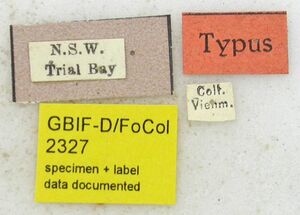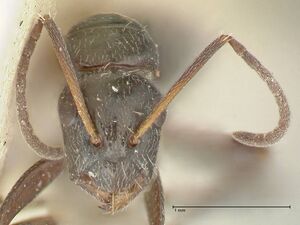Camponotus cameratus
| Camponotus cameratus | |
|---|---|

| |
| Scientific classification | |
| Kingdom: | Animalia |
| Phylum: | Arthropoda |
| Class: | Insecta |
| Order: | Hymenoptera |
| Family: | Formicidae |
| Subfamily: | Formicinae |
| Tribe: | Camponotini |
| Genus: | Camponotus |
| Species: | C. cameratus |
| Binomial name | |
| Camponotus cameratus Viehmeyer, 1925 | |
Identification
Keys including this Species
Distribution
Distribution based on Regional Taxon Lists
Australasian Region: Australia (type locality).
Distribution based on AntMaps
Distribution based on AntWeb specimens
Check data from AntWeb
Countries Occupied
| Number of countries occupied by this species based on AntWiki Regional Taxon Lists. In general, fewer countries occupied indicates a narrower range, while more countries indicates a more widespread species. |

|
Estimated Abundance
| Relative abundance based on number of AntMaps records per species (this species within the purple bar). Fewer records (to the left) indicates a less abundant/encountered species while more records (to the right) indicates more abundant/encountered species. |

|
Biology
Castes
            
| |
| . | |
Nomenclature
The following information is derived from Barry Bolton's Online Catalogue of the Ants of the World.
- cameratus. Camponotus (Myrmogonia) cameratus Viehmeyer, 1925b: 146 (s.w.) AUSTRALIA (New South Wales).
- Type-material: syntype major and minor workers (numbers not stated).
- Type-locality: Australia: New South Wales, Trial Bay (H. Overbeck).
- Type-depository: MNHU (perhaps also SMTD).
- Subgenus indeterminate: Ward, et al. 2016: 351.
- Status as species: Taylor & Brown, 1985: 110; Taylor, 1987a: 11; Bolton, 1995b: 90; McArthur, 2014: 144.
- Distribution: Australia.
Type Material
- Camponotus (Myrmogonia) cameratus Viehmeyer, 1925: Syntype, worker(s), Trial Bay, New South Wales, Australia, Berlin Museum für Naturkunde der Humboldt-Universität.
Unless otherwise noted the text for the remainder of this section is reported from the publication that includes the original description.
Description
Worker major. Head trapezoidal, with anteriorally weakly curved, moderately converging sides, strongly rounded posterior corners, flatly concave posterior margin. Clypeus slightly arched with moderately diverging sides with hardly a keel with anterior margin produced somewhat, in the middle there is a very slight indentation and in front of this there is a dimple shaped impression. Frontal area indistinct; frontal ridges diverging strongly backward; very fine and very flat frontal groove located on a raised up plateau. The anterior margin of the flatly arched eyes is clearly positioned in front of the middle of the head. The scapes exceed the back of the head by about the length of the first segment. The mandibles are short, thick strongly curved on the outside edge with 6 teeth. Thorax arched lengthwise, up to the short sloping concave surface of the epinotum forming a curve, distinct promesonotal suture, indistinct or absent mesoepinotal suture with indistinctly separated metanotum. The basal surface of the epinotum is twice as long as the declivity and joins the declivity in a flatly rounded curve. Apart from the strongly transverse flat, anteriorly rounded pronotum the thorax is very convex, the epinotum (= propodeum) is slightly compressed at its sides. Node about 3 times as wide as long with parallel front and back surfaces, the latter slightly higher, the overall surfaces somewhat rounded and sloping from front to back.The entire body reticulate with the front part of the head very narrow and sharp, integument here is absolutely dull. On top of the head less blunt; thorax slightly, anterior part of the head, node, gaster strongly glossy. At the front of the head and at the top of the head there is an accumulation of piligerous points, those at the front are sometimes elongated but generally quite shallow. Erect hairs yellowish white, scattered, only on the front of the head more dense; adpressed hair also scattered, short, white; limbs only with flat-lying hair. Limbs; the flexor side of the hind tibias are without spines. Black; Apical half of the mandibles, base of the scapes of the antennae red brown, limbs light brown, far end of coxa and trocanter brownish yellow.
Worker minor. Form of the head is very similar, but the clypeus is with a keel, not stretched out nor has it an indentation; mandibles less curved, thinner; Scapes exceed the anterior margin of the head by a good 1/3 of its length. Sloping surface of the epinotum is not convex forming an edge with the remaining dorsum profile; Node is quite column shaped, not less than twice as wide as long. Front of the head not so blunt and without the group of piligerous points. Length 4.2-6.2 mm.
Trail Bay. Solitary.
References
- Bolton, B. 1995b. A new general catalogue of the ants of the world. Cambridge, Mass.: Harvard University Press, 504 pp. (page 90, catalogue)
- Heterick, B.E. 2021. A guide to the ants of Western Australia. Part I: Systematics. Records of the Western Australian Museum, Supplement 86, 1-245 (doi:10.18195/issn.0313-122x.86.2021.001-245).
- Viehmeyer, H. 1925b. Formiciden der australischen Faunenregion. (Schluss.). Entomol. Mitt. 14: 139-149 (page 146, soldier, worker described)
References based on Global Ant Biodiversity Informatics
- Viehmeyer H. 1925. Formiciden der australischen Faunenregion. (Schluss.). Entomologische Mitteilungen. Berlin-Dahlem 14: 139-149.

